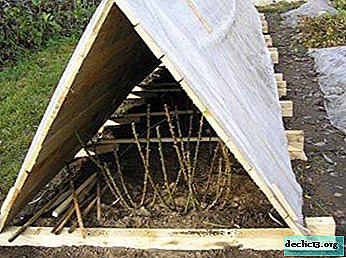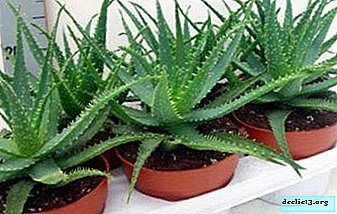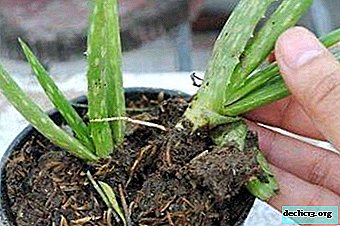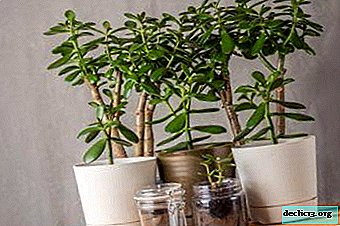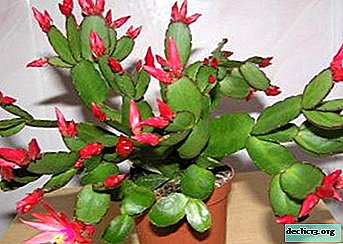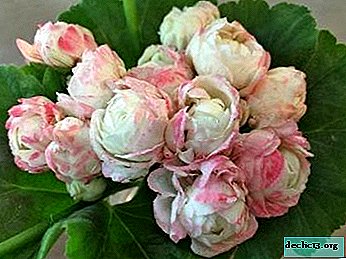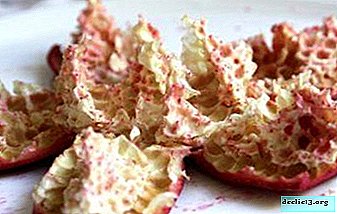How to plant radish seedlings? Normal and snail cultivation

The root crop appeared on domestic tables since the time of Peter the Great and immediately this juicy, bright vegetable gained recognition throughout the Russian territory.
The opportunity to open the garden season for those who like to tinker with in the beds and the desire to crunch with the first spring salads is an excellent reason for planting radishes.
This article talks about whether this root crop can be planted in a seedling method, and also what are the ways of sowing seeds.
Is it possible to plant a radish seedling method?
There are two ways to grow root crops:
- The most common - sowing seeds in early spring immediately in the beds.
- Using the second method - growing seedlings with subsequent transplantation into the garden - you can get the first crop earlier by 1.5 weeks.
When to sow?
Harvested radishes planted with seedlings in early spring and autumn, i.e. twice a year. You can plant seeds for seedlings:
- from February to the end of April;
- from the second half of September to the beginning of October.
Planting time depends only on the lack or excess of sunlight required by the radish for normal growth. Also, radish does not tolerate heat.
Landing in the usual way
For planting, radish seeds are calibrated, i.e. the largest are selected. Mixing varieties or hybrids is not recommended.
It is better to buy seeds that are dragee - treated with fertilizers and protected from diseases.In the future, this will favorably affect germination and seedling growth.
 Thanks to modern technology, radish seeds in Moscow and St. Petersburg can be bought without leaving home on the Internet. The price ranges from 16 to 25 rubles. for 2g. Same buy seeds at a specialty store. Varieties for planting choose resistant to lack of light and quickly ripening. Seeds can be planted both dry and soaked. In the second case, they germinate faster, and on the second day sprouts can hatch.
Thanks to modern technology, radish seeds in Moscow and St. Petersburg can be bought without leaving home on the Internet. The price ranges from 16 to 25 rubles. for 2g. Same buy seeds at a specialty store. Varieties for planting choose resistant to lack of light and quickly ripening. Seeds can be planted both dry and soaked. In the second case, they germinate faster, and on the second day sprouts can hatch.
To increase the immunity of the plant, the seeds are soaked in 1% manganese solution for 20 minutes. Then washed in running water.
Seed preparation
- We check the seeds for germination - we place the seeds in a container with water. Those that have surfaced are thrown out.
- Soak the remaining seeds for 8-12 hours. Soaking can be done in plain water or in stimulating solutions. To do this, lay the napkin on a saucer, moisten with water and spread the seeds on it. Cover with moistened gauze on top so that no seeds come up.
- Put the saucer in a plastic bag. So moisture will not evaporate. Put everything in a warm place.
After one or two days, the grains will hatch, and they can be planted in the ground.
Planting radishes for seedlings is possible in two ways:
- ordinary (in cups or cells);
- or in the "snail".
Procedure

- In small peat cups or cardboard cells for eggs, pour soil for seedlings, ram.
- We humidify the earth.
- In each cup or cell, lay out one pecked seed to a depth of not more than 1.5 cm, lightly ram.
- Water and cover with a film. Raise the film every day for ventilation.
- After the first true leaf appears, seedlings are planted in the garden.
Many are afraid to transplant radish seedlings, because they do not know whether this can be done without causing harm to the seedlings. Radish seedlings are very fragile, so you need to plant it in glasses. And egg cells can be buried whole in the ground or cut into strips and planted in rows.
An earthen ball when growing radishes should be constantly wet. After a drought, radishes will grow in color and will not produce good fruits.Snail cultivation
Consider how to grow seedlings in a snail.
- Laid out in two or three layers of toilet paper with a strip of approximately 1.5 m spread on the table.
- On a paper we lay out a moist layer (not more than 1 cm) of moistened earth and lightly tamp.
- We carefully place the radish seeds with tweezers, stepping back from the edge of 2 cm, and 2-3 cm at intervals from each other. Slightly deepen the grains with your fingers so that later they do not fall out.
- Moisten the strip again with a spray gun.
- Gently, we begin to roll our snail into a roll. We put on the finished snail on top and bottom with an elastic band so that it does not unwind.
- Turn the cochlea over so that the seeds are at the top. The crumbled earth is returned to the snail.
- We lay the roll in a container prepared by volume.
- For a greenhouse effect, put a bag on the snail and secure it with an elastic band.
- After the first shoots, we remove the package, and at the first real leaf we plant seedlings in the ground. To do this, it is enough to make a groove in the ground, gently unfold the paper with sprouts, lay it in the groove and sprinkle with earth.
Seedlings stretched out: what is it, why is it happening, what to do?
 If you didn’t immediately succeed in transplanting the seedlings, and it stretched out, there are two reasons for this phenomenon:
If you didn’t immediately succeed in transplanting the seedlings, and it stretched out, there are two reasons for this phenomenon:
- The first is the lack of intense light, additional lighting is needed.
- And the second - increased air temperature. For radishes, the optimum temperature is up to 18 degrees. And in the room we usually have more. Therefore, you need to find a cool place for seedlings.
Diseases and pests: how to overcome and prevent?
Radish is an early ripe vegetable, so it rarely gets sick. Yes, and pest eggs do not have time to develop. But, nevertheless, sometimes fungal and viral diseases develop, and insects damage seedlings. We know that disease is easier to prevent than to cure. Therefore, special attention should be paid to prevention. Inspecting the beds every 4-5 days helps to notice the problem on time.
Belle of cabbage crops (white rust)
All cruciferous suffer to some extent from this disease. But, it is especially dangerous for young radish plants. Cool rainy weather, sudden changes in temperature contribute to the development of the fungus. Light green spots form on the front side. The tissues in these places thicken, gradually turn brown and die. With severe damage, special drugs are used.
For prevention, a solution of manganese, soda or colloidal sulfur is used (10-15 g per 10 l).
Preventive spraying is carried out once a week or more often if it rains continuously. Ill plants are sprayed 3-4 times after 4-5 days.Kila
 With this disease, the entire crop may die. In beds with a keel affection, cruciferous plants are not planted for 8-10 years. The term can be reduced to 4-5 years by planting there nightshade or legume crops. At the moment, the treatment of keel has not been developed. Therefore, the focus is on prevention.
With this disease, the entire crop may die. In beds with a keel affection, cruciferous plants are not planted for 8-10 years. The term can be reduced to 4-5 years by planting there nightshade or legume crops. At the moment, the treatment of keel has not been developed. Therefore, the focus is on prevention.
The keel on the roots appears in the form of growths, gradually they turn brown and rot. Contribute to the development of this disease:
- frequent watering;
- heavy soil;
- high temperature (from 25 degrees).
Currently, the treatment of keel has not been developed. Therefore, the focus is on prevention.
For prevention, the garden 2-3 hours before planting is watered with lime mortar (2 tbsp. Slaked lime per 10 l of water). Soaking seeds in a Cumulus solution also helps.
Blackleg
Amazed young shoots. The base of the stem blackens, seedlings fall, the plant disappears. As a rule, plants can no longer help. The fungus loves stale air, heat and acidified soil. For prevention, the seeds are soaked in a dark raspberry solution of manganese. To the bases of seedlings pour chalk or ash. Water for irrigation is sometimes replaced by Fotosporin M. From folk remedies - they make an infusion of onion husks or green marigolds.
In addition to diseases, insects also damage the crop. Consider which of the pests can eat plants.
- Cruciferous fleas - destroy the tops. To control insects use ash or tobacco dust, sprinkling a plant.
- Nutcracker Beetles - prefer young shoots. Nutcracker beetles feed on young leaves, and their larvae feed on root crops. Ammonium sulfate fertilizers will help get rid of the pest.
- Cabbage Moth and Cabbage Fly - caterpillars of these insects can completely destroy young leaves. Solutions based on naphthalene, camphor, slaked lime will help get rid of moths and flies.
- Aphid - eats the juice of plant leaves. Entire colonies of insects cling to the inside of young leaves. As a result, the leaves turn yellow and dry. The aphid does not tolerate strong odors of plants such as marigolds, calendula, lek, garlic. Infusions are prepared from them and radish leaves are sprayed.
Radish is an unpretentious plant. Taking very little time to prevent radish diseases, we get a juicy, bright root crop, rich in vitamins, which we so need in the spring.

